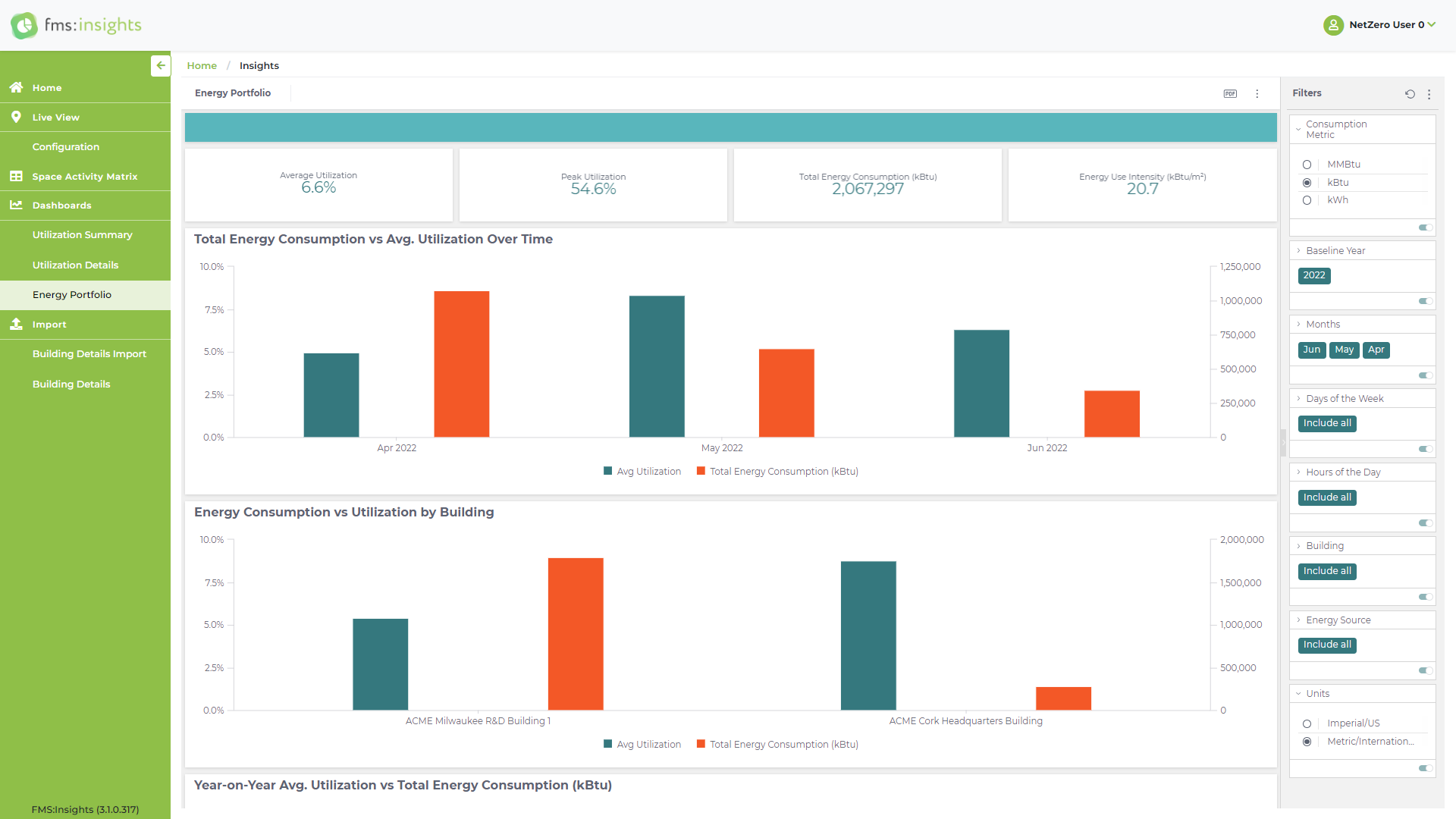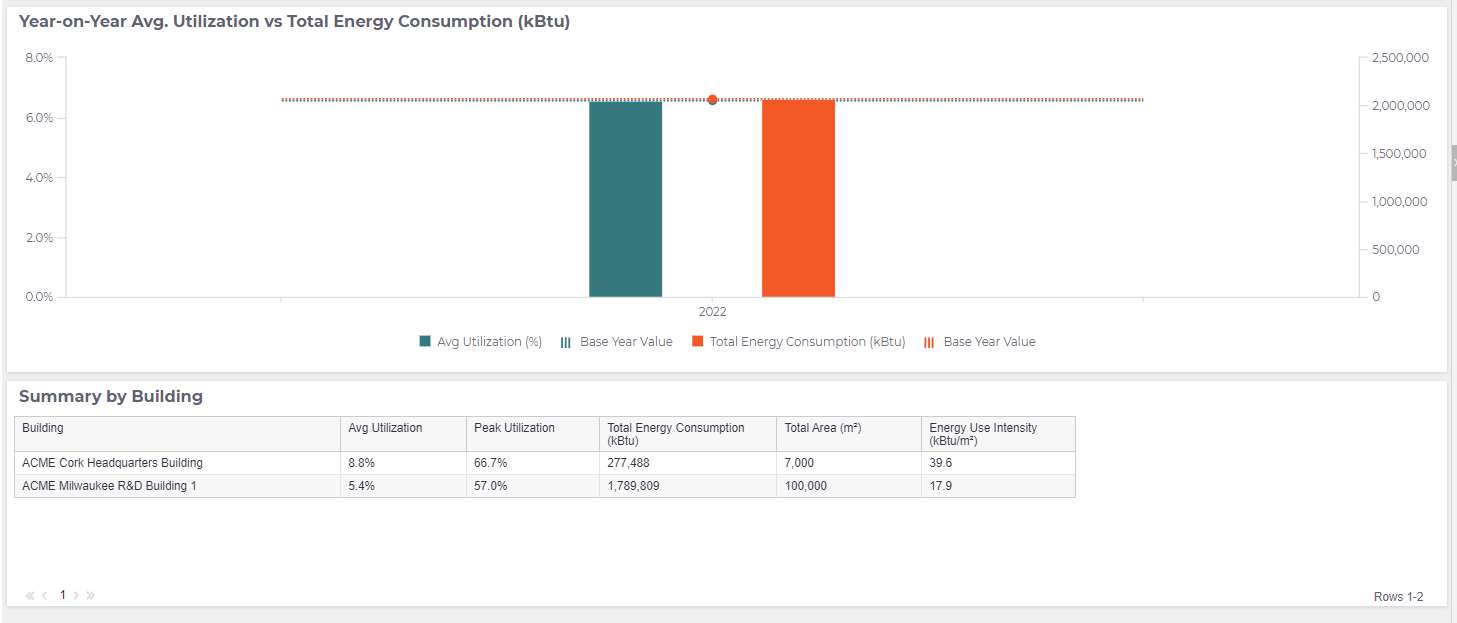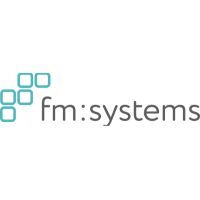FMS:Insights
Energy Dashboard reveals relationship between space utilization & energy consumption


Climate change poses a dire threat to individuals and businesses alike, and experts agree that the only way to slow it down is to reduce emissions of the greenhouse gases (GHG) that are causing it. Ideally, humanity needs to reach a point where these gases, like carbon dioxide and methane, are being removed from the atmosphere at the same rate they’re being added. The problem is that the world is running out of time to achieve this equilibrium, known as net zero, before the impacts of climate change become irreversible. According to the United Nations, in order to limit global warming to 2.7 degrees Fahrenheit, emissions need to be cut by 45 percent over the next five years and reach net zero by 2050.
Many organizations are doing their part to combat climate change by taking steps to attain this balance within their business. In fact, 65 percent of the world’s 2,000 biggest companies have set a net zero goal, according to a recent report by Accenture. That’s up from 39 percent in 2021. But that same study shows that only 16 percent of these companies are on track to meet these net zero targets.
Fortunately, technology solutions are emerging that facility managers (FMs) can use to help organizations get stalled net zero initiatives moving again. One such advancement is the integration of the Johnson Controls sustainability platform, Net Zero Advisor, into the FM:Systems workplace analytics platform, FMS:Insights.
What are Net Zero Advisor & FMS:Insights?
Net Zero Advisor is a component of Johnson Controls OpenBlue Enterprise Manager (OBEM), a comprehensive building performance management platform. FMs use the module within OBEM to monitor energy consumption and resulting greenhouse gas emissions. Net Zero Advisor was developed to meet the needs of companies trying to reduce carbon emissions and improve energy efficiency in response to environmental regulations and sustainability goals.
FMS:Insights is a multi-data point analysis platform featuring native integration to streamline workplace spatial and bookings data, as well as occupancy and environmental sensor data. Launched in 2022, the module leverages data from sensors and other sources to automate data gathering, aggregation, analysis, and reporting on workplace utilization and employee mobility. FMS:Insights features interactive maintenance performance and real estate portfolio summary dashboards to keep decision-makers informed on these KPIs and benchmarks for strategic planning.
FM:Systems and Johnson Controls have married the capabilities of Net Zero Advisor and FMS:Insights into the Energy Dashboard.
The Energy Dashboard paints the whole picture
Organizations using Net Zero Advisor can see energy data and equate that information with GHG emissions volumes, but aren’t able to combine those data points with space utilization data. On the other hand, FMS:Insights users are able to view space utilization data to understand how their offices are being used. Prior to the integration with Net Zero Advisor, FMS:Insights users who wanted to understand the relationship between utilization and energy cost and consumption had to export the former and merge it with the latter in a spreadsheet application. The Energy Dashboard simplifies this process significantly by using an application program interface to collect data from those sources and make it easily accessible in one place. The resulting information can be segmented by time dimension or location.
Now, FMS:Insights users can access, view and analyze energy cost and consumption information and space utilization data side-by-side in a single platform, without the need for additional steps or external tools. By automatically combining utilization data with energy usage data, the Energy Dashboard makes it easier for FMs to understand the complex relationship between energy consumption, emissions and space utilization. These enhanced insights can also reveal new opportunities to optimize energy usage, decrease spending and waste, and support sustainability initiatives. Finally, the integration of Net Zero Advisor into FMS:Insights streamlines reporting to aid investor relations activities and ESG and regulatory compliance.
Putting new insights to good use
Organizations interested in accessing FMS:Insights and the Energy Dashboard don’t have to deploy an all-encompassing smart building system first. They can start using these solutions “out of the box” with just an array of occupancy sensors and a data feed from their utility provider.
Even with this basic deployment, the Energy Dashboard enables FMs to easily identify times when energy consumption is high despite low space utilization. This insight can be instrumental in identifying suboptimal equipment performance or faulty building components. FMs can then take action to address these issues, reducing costs and energy waste. Organizations can also use the space utilization and energy consumption patterns revealed by the Energy Dashboard to support better decisions about when and where it makes sense to incorporate sustainable energy sources.
To get the most out of the integration of Net Zero Advisor into FMS:Insights, however, organizations can deploy additional internet of things (IoT) devices, such as environmental sensors, smart meters, and equipment performance monitors. This hardware provides additional and more varied layers of data, allowing for deeper insights when combined with utilization and energy data.

Enhanced capabilities on the horizon
Currently, the Energy Dashboard enables users to combine energy consumption with utilization data. In the near future, users will be able to marry consumption data with other data streams, like indoor air quality (IAQ) or equipment performance.
Combining energy consumption data with maintenance performance data can help FMs optimize building efficiency. For example, if energy usage spikes when maintenance is delayed on HVAC systems, FMs can prioritize timely maintenance to reduce energy waste. This combination provides a comprehensive picture of how equipment performance impacts energy consumption, leading to better resource allocation and reduced operational costs.
FM:Systems and Johnson Controls development teams are working together to add emissions data to the existing energy and utilization metrics within FMS:Insights. This will allow organizations to track not only energy consumption but also the corresponding carbon emissions generated by their energy use. Integrating emissions data will give stakeholders an even more comprehensive view of the environmental impact of their spaces and portfolio. This can be particularly helpful in portfolio management, where real estate teams need to prioritize energy efficiency across multiple buildings in different locations.
For example, users will be able to analyze how specific actions, such as reducing occupancy in low-use areas or optimizing HVAC systems, can lead to both energy savings and reductions in emissions. This feature will further support ESG reporting and net zero compliance, helping companies meet stricter environmental regulations and achieve sustainability goals more effectively. The expanded data set also opens the door for future artificial intelligence (AI)-driven insights, allowing FMs to optimize energy usage and emissions reduction strategies automatically.
Supercharging decarbonization with AI
More than three-quarters of business leaders responding to the FM:Systems 2025 Inside the Workplace survey plan to deploy generative artificial intelligence (GenAI) in the next year to assist with the operations and maintenance of workplaces. Over a third of organizations plan to adopt machine learning (ML), which enables computerized systems to leverage large data sets to learn and get better at their appointed task, without the need for programming. While the Energy Dashboard is a big leap forward for organizations trying to make progress toward net zero goals, deploying it in combination with solutions powered by advanced technologies like GenAI and ML will make it an even more powerful tool in the pursuit of sustainability, cost reduction and efficiency targets.
Data is the lifeblood of workplace and smart building technologies like Net Zero Advisor, FMS:Insights and the Energy Dashboard. In organizations with larger or more complex property portfolios, this data can amount to terabytes of information coming from hundreds of sources, including occupancy sensors, smart meters, access control systems and room- and desk- booking software. ML and GenAI makes the process of collecting, organizing and deriving value from all this data much easier, which in turn unlocks a whole new world of insights to help support better decision-making.
GenAI and ML-powered features are being developed for Net Zero Advisor, FMS:Insights and the Energy Dashboard so that, in the near future, these solutions – paired with autonomous building features – can help empower buildings to reduce energy consumption and waste, improve efficiency and optimize maintenance without requiring human intervention.
Conclusion
While many companies are making good progress toward net zero goals, the majority are struggling to sustain momentum and uncover new ways to reduce emissions. To get these initiatives back on track and reveal new opportunities for more sustainable operations, organizations need to unlock fresh insights into the connection between utilization and energy consumption across their portfolios. Using innovations like the Energy Dashboard, FMs can deliver these new insights and empower their organization to make proactive, data-driven decisions, cut costs, improve efficiency and simplify reporting.

Read more on
Explore All FMJ Topics







